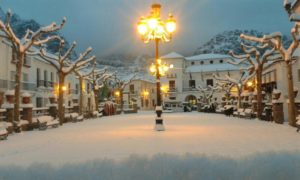 The town of Grazalema, highest pueblo blanco in the Sierra de Grazalema, sits in a natural bowl of land, one of the ‘hanging valleys’ found in the high sierras, beneath the Penon Grande and El Endrinal, with the peak of San Cristobal beyond. Settled since Roman times – there is a Roman villa called Lacidulia nearby and other remains from that period are regularly found during building works – the town was occupied by Berbers from 8th century until the re-conquest by the Christians, when it was called Zagrazalema. It was partially destroyed during the Napoleonic era.
The town of Grazalema, highest pueblo blanco in the Sierra de Grazalema, sits in a natural bowl of land, one of the ‘hanging valleys’ found in the high sierras, beneath the Penon Grande and El Endrinal, with the peak of San Cristobal beyond. Settled since Roman times – there is a Roman villa called Lacidulia nearby and other remains from that period are regularly found during building works – the town was occupied by Berbers from 8th century until the re-conquest by the Christians, when it was called Zagrazalema. It was partially destroyed during the Napoleonic era.
At its heart is the Plaza de España and the Town Hall, with the Arts Centre and the 18th century Iglesia de  la Aurora close by. Its streets are narrow and stretch back from this focal point, upwards towards the looming rocky outcrop that is part of the Penon Grande. Tiled panels explaining the history and the stories behind the history can be found at points throughout the town, a charming way to inform the visitor (if one speaks Spanish).
la Aurora close by. Its streets are narrow and stretch back from this focal point, upwards towards the looming rocky outcrop that is part of the Penon Grande. Tiled panels explaining the history and the stories behind the history can be found at points throughout the town, a charming way to inform the visitor (if one speaks Spanish).
In this way one learns about the origin of the Moorish name and a local tale, based, apparently, upon fact, about the astonishing appearance of the renowned bandit or bandelero El Tempranillo, (1805-1833), to baptise his son in the Church of the Aurora. This Robin Hood like character defied capture, despite the price on his head and ended up with a pardon and the equivalent of a sheriff’s badge. In the 19th century British traveller and writer John Ford wrote about El Tempranillo and Ford’s friend, the artist John Frederic Lewis, sketched him. The Sierra was a popular haunt of bandeleros, in fact and in fiction.
 Grazalema is split into two main zones – the ‘low town’ around the Plaza de España and the ‘high town’ further up the bowl of land. The first is older and grander, historically, the ‘smart’ end of town, whilst the higher barrio is younger and, traditionally, more working class. The boundary between the two is marked by a public drinking fountain, thought to include a stone Roman trough. Historically there is said to be rivalry between the two parts of town, which is played out annually via various sporting contests.
Grazalema is split into two main zones – the ‘low town’ around the Plaza de España and the ‘high town’ further up the bowl of land. The first is older and grander, historically, the ‘smart’ end of town, whilst the higher barrio is younger and, traditionally, more working class. The boundary between the two is marked by a public drinking fountain, thought to include a stone Roman trough. Historically there is said to be rivalry between the two parts of town, which is played out annually via various sporting contests.
There are a number of small hotels in the town, as well as some larger ones just outside (though within walking distance). The town is popular as a base from which to walk the Sierra, with Spanish as well as foreign tourists,  though, please note, English is not widely spoken.
though, please note, English is not widely spoken.
The young woman who served us at lunch was happy to chat, she says that these days the town’s economy does as well out of rural tourism as it does from the more traditional agrarian activities, though – and this surprised me – there are as many, if not more, visitors in Winter as in Summer. Now high Summer would be far too hot for walking or climbing, but I had thought Spring and Autumn would be the busy times, not Winter. It is, apparently, the snow which attracts the visitors. I confess it is very pretty, see right, but I wouldn’t want to drive on those mountain roads at that time of year. Next Spring, however, I plan to return.
If you enjoyed reading about this part of Spain try Journey Through the Pinsapar Benamahoma to El Bosque Country Food Arcos de la Frontera Inside Out on the Camino


 RSS – Posts
RSS – Posts
2 responses to “Grazalema”